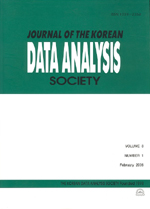노년기 삶의 질(CASP-19)에 대한 종단적 분석
The CASP-19 measure and the Longitudinal Analysis of the Quality of Life in Later Life
- 한국자료분석학회
- Journal of The Korean Data Analysis Society (JKDAS)
- Vol.23 No.1
-
2021.02333 - 352 (20 pages)
-
DOI : 10.37727/jkdas.2021.23.1.333
- 374

본 연구는 시간의 흐름에 따른 노인의 삶의 질 변화 양상과 예측 요인을 살펴보는 것을 목적 으로 한다. 이를 위해 영국 고령화 패널(ELSA)의 4차에서 8차까지 최근 10년 동안 수집된 65세이상의 노인 5,178명의 데이터를 활용하여 종단적으로 분석하였다. 노인에게 특화된 삶의 질 척도인 CASP-19를 활용하였으며 이 척도는 통제감 영역, 자율성 영역, 자기실현 영역, 즐거움 영역의 총 4개의 하위 영역으로 구성되었다. 잠재성장모형을 통하여 노년기 삶의 질의 변화 모형을 도출하고자 하였고 삶의 질의 초기값과 변화율에 영향을 주는 변인을 살펴보았다. 분석 결과 첫째, 노인의 삶의 질은 시간 경과에 따라 점차 선형적으로 감소하는 것으로 나타났으며 하위 영역별 분석에서도 비슷한 양상을 보였다. 둘째, 연령은 초기값과 변화율에 공통적으로 영향을 주는 중요한 변수였다. 셋째, 잠재성장모형의 초기값과 변화율에 영향을 미치는 요인으로는 연령, 주관적 건강 상태, 교육 수준, 사회 참여, 가족 관계, 수급 여부, 소득수준 등이었으며 하위 영역에 따라 차이를 보였다. 이러한 결과를 토대로 노인의 삶의 질의 영역과 변화에 대한 심층적 이해를 도모하고 삶의 질 향상을 위한 효율적 개입에 대하여 논하였다.
The purpose of this study is to identify the trajectories of change in older people’s quality of life and to explore the predictors of changes. Data were from the latest five waves(wave4-8) of English Longitudinal Study of Ageing(ELSA), a prospective nationally representative study of community dwelling older people in the UK. The data of 5,178 respondents who aged 65 and over were used for the final analysis. The CASP-19 developed specially for older people was used as the quality of life(Qol) measure by self-completion questionnaire and it has four derived domains of control, autonomy, self-realization and pleasure. To examine trajectories of change over time in quality of life and its predictors, the latent growth curve(LGC) methodology was used. As result, the quality of Life in later life decresed over time at all dimensions of Qol. And the factor predicting the intercept and slope of the Qol in LGC is found to be ‘age’, which was lowering the baseline of the Qol. Age, self-rated health, education, chronic illness, social participation, family relation, welfare benefit status, marital status, income has significant impact on the Qol in Later life. further implications of the study were discussed.
1. 서론
2. 선행 연구 고찰
3. 연구 방법
4. 연구 결과
5. 논의 및 결론
References
(0)
(0)